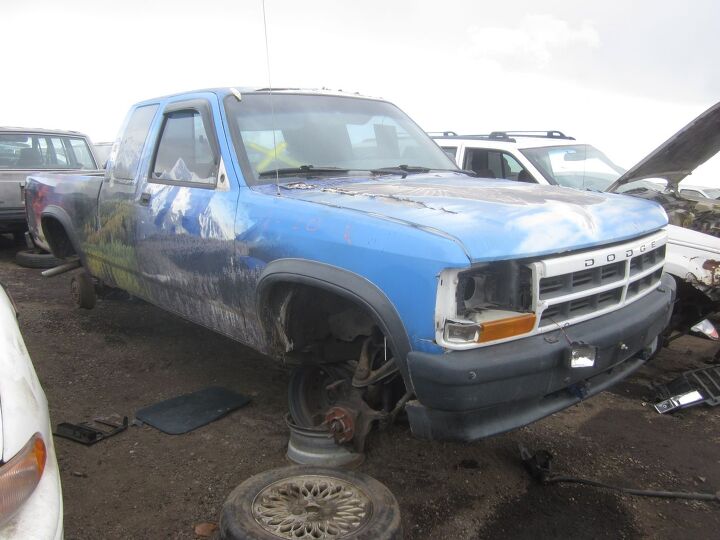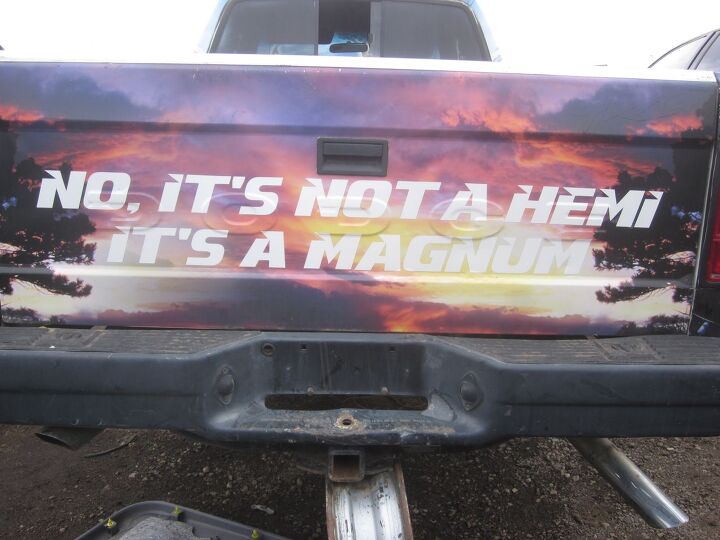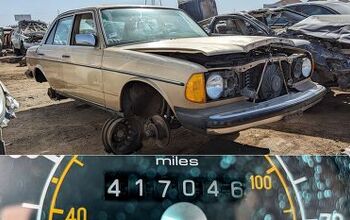Junkyard Find: NO, IT'S NOT A HEMI!

The good old Chrysler 318 engine has been around since, oh, around the start of the Iron Age. From about 1,000 BC to 2002 AD, the 318 and its LA engine relatives were installed in Chrysler products, and they did a fine job. If it hadn’t been for the cockroach-grade immortality of the Chrysler Slant Six, in fact, we’d probably be talking about the 318 as the most unkillable engine Detroit ever made. In 1992, Chrysler updated the 318 (which had gone to a roller cam a few years before) with high-pressure multi-point fuel injection and more emission-friendly heads… and they called it the 5.2 Magnum, no doubt because the original Dodge Magnum hadn’t been good enough to justify such a cool name. As I discovered in a Denver wrecking yard last week, at least one Dakota owner was proud enough of his Magnum to apply a full-body vinyl wrap to his truck.
I’m hoping that this truck was owned by a shop specializing in hot-rodded Magnums for the off-road crowd, or some sort of outdoorsy engine-related business, because getting a screaming-eagles-and-virgin-forest vinyl wrap job for a Dakota seems somewhat creepy otherwise.
Here it is: Magnum.
I might be talking heresy here, but a Hemi in a Dakota sounds like a fine idea to me.

Murilee Martin is the pen name of Phil Greden, a writer who has lived in Minnesota, California, Georgia and (now) Colorado. He has toiled at copywriting, technical writing, junkmail writing, fiction writing and now automotive writing. He has owned many terrible vehicles and some good ones. He spends a great deal of time in self-service junkyards. These days, he writes for publications including Autoweek, Autoblog, Hagerty, The Truth About Cars and Capital One.
More by Murilee Martin
Latest Car Reviews
Read moreLatest Product Reviews
Read moreRecent Comments
- Honda1 Unions were needed back in the early days, not needed know. There are plenty of rules and regulations and government agencies that keep companies in line. It's just a money grad and nothing more. Fain is a punk!
- 1995 SC If the necessary number of employees vote to unionize then yes, they should be unionized. That's how it works.
- Sobhuza Trooper That Dave Thomas fella sounds like the kind of twit who is oh-so-quick to tell us how easy and fun the bus is for any and all of your personal transportation needs. The time to get to and from the bus stop is never a concern. The time waiting for the bus is never a concern. The time waiting for a connection (if there is one) is never a concern. The weather is never a concern. Whatever you might be carrying or intend to purchase is never a concern. Nope, Boo Cars! Yeah Buses! Buses rule!Needless to say, these twits don't actual take the damn bus.
- MaintenanceCosts Nobody here seems to acknowledge that there are multiple use cases for cars.Some people spend all their time driving all over the country and need every mile and minute of time savings. ICE cars are better for them right now.Some people only drive locally and fly when they travel. For them, there's probably a range number that works, and they don't really need more. For the uses for which we use our EV, that would be around 150 miles. The other thing about a low range requirement is it can make 120V charging viable. If you don't drive more than an average of about 40 miles/day, you can probably get enough electrons through a wall outlet. We spent over two years charging our Bolt only through 120V, while our house was getting rebuilt, and never had an issue.Those are extremes. There are all sorts of use cases in between, which probably represent the majority of drivers. For some users, what's needed is more range. But I think for most users, what's needed is better charging. Retrofit apartment garages like Tim's with 240V outlets at every spot. Install more L3 chargers in supermarket parking lots and alongside gas stations. Make chargers that work like Tesla Superchargers as ubiquitous as gas stations, and EV charging will not be an issue for most users.
- MaintenanceCosts I don't have an opinion on whether any one plant unionizing is the right answer, but the employees sure need to have the right to organize. Unions or the credible threat of unionization are the only thing, history has proven, that can keep employers honest. Without it, we've seen over and over, the employers have complete power over the workers and feel free to exploit the workers however they see fit. (And don't tell me "oh, the workers can just leave" - in an oligopolistic industry, working conditions quickly converge, and there's not another employer right around the corner.)













































Comments
Join the conversation
There was absolutely nothing wrong with the transmissions in the 90's dakotas. The A-500 that came behind the V6 and 318 2WD models was the 999 torgueflite with an electric overdrive unit added to the tailshaft. Same thing with the A-518 used in the 318 4X4's. It was the rugged 727 with overdrive on the tailshaft. Other than the overdrive they used the same parts as the older torqueflites, even filters and gaskets interchanged. The switch that activates the overdrive was known to go bad, which was an esay fix. Some people even bypassed it and used a toggle switch on the dash. Starvingteacher, the 318 was tougher than a 283 for the same reasons that all other A engines were togher than small block chevies. Higher nickel content in the block, with thicker bulkheads and beefier main caps with bigger bolts. They also used longer and beefier rods and and the head bolts were further from the bore resulting in less bore distortion than a chevy. The mopar also used bigger diameter lifters with wider cam lobes and a better hardening process than the chevy. That was why worn cams were a rare sight on mopars, very common on chevies before they switched to the roller design in 87. The 440 Magnum was a highly respected engine back in the day because it was chrysler's top dog on the street. They only sold around 2k hemi's a year due to the high price, and the majority of those sold ended up on the drag strip, they were a very rare sight on the streets.
From where I stand, Murilee, you're not talking heresy. A 3G Hemi would be a perfect powerplant for a Dakota. As for the Magnum engine itself, I could imagine it being installed in an old specialty car from the 1950s, perhaps something from LaDawri or Victress.